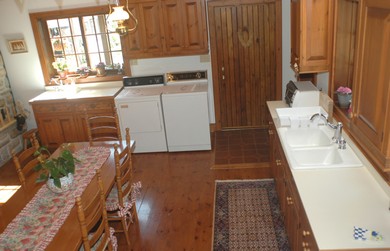More than 25 years ago I made a home building decision that has saved my wife and I the equivalent of more than 300 round trips up and down the CN Tower staircase on foot. By opting to put our washer, dryer and laundry sink right out in the open – in the kitchen itself – we’ve avoided climbing more than a million stairs over the years. I call this the “kitchen laundry” feature, and there’s more reason than ever to consider the time saving and labor-saving benefits of this little-used floor plan.
 When I was a boy, laundry appliances were ugly, really ugly. That’s why the concrete sinks, the Soviet-style brass taps and sinister-looking rubber hoses always got relegated into a dark basement corner downstairs. But the aesthetics of laundry appliances have improved enough that there’s no reason to be embarrassed anymore. Some of the most beautiful sinks and faucets are now designed for laundry duty, and they’ll please even the most demanding home decor purists. Why travel up and down stairs for laundry when you don’t have to?
When I was a boy, laundry appliances were ugly, really ugly. That’s why the concrete sinks, the Soviet-style brass taps and sinister-looking rubber hoses always got relegated into a dark basement corner downstairs. But the aesthetics of laundry appliances have improved enough that there’s no reason to be embarrassed anymore. Some of the most beautiful sinks and faucets are now designed for laundry duty, and they’ll please even the most demanding home decor purists. Why travel up and down stairs for laundry when you don’t have to?
You’ll find laundry sinks available in all the best materials these days and this is where you need to start. The key is to create a matching combination of laundry and kitchen sinks, with matching faucets, too. Our own set-up includes a Kohler enameled cast-iron sink that still looks great after a quarter-century of use. Ten years ago I upgraded the white fiberglass laundry sink I originally installed with another Kohler cast-iron kitchen-style sink and taps that popped right into the existing cabinet. This combination is beautiful, functional and very efficient. If laundry sinks and taps had been made this well all along, no one would ever have considered putting them in the basement in the first place.
But old attitudes die hard, and that’s why few kitchens (even brand new ones) are built with the kind of water lines, drain pipes and electrical wiring needed to supply a washer and dryer as part of a kitchen floor plan.
Want to upgrade? Although you’ll need to complete some modifications before you can enjoy the benefits of a kitchen laundry in your own home, there’s a little-known plumbing trick that will reduce the hassle of hooking up drains. And it comes thanks to a small plumbing fixture called a ‘check valve’.
To operate properly, all plumbing drains need to be vented. This allows air to flow back into the pipes as wastewater moves down through the system and out of your home. Without this replacement air, a low-pressure vacuum develops inside drainpipes, causing gurgling operation; slow drainage action and the possibility of sewer gases making their way into your home.
 The best way to vent drain pipes is by connecting them to a secondary system of pipes that exits out of the roof of your house. This allows replacement air back into the system, neutralizing the vacuum and eliminating problems. Trouble is, this vent connection must be made close to the fixture being drained, and that’s not always easy to do. In fact, when you’re adding drainpipes to an existing home, the job of conventional vent pipe hook-up can be almost impossible sometimes. This is where a check valve really helps. You can see one I installed to the left.
The best way to vent drain pipes is by connecting them to a secondary system of pipes that exits out of the roof of your house. This allows replacement air back into the system, neutralizing the vacuum and eliminating problems. Trouble is, this vent connection must be made close to the fixture being drained, and that’s not always easy to do. In fact, when you’re adding drainpipes to an existing home, the job of conventional vent pipe hook-up can be almost impossible sometimes. This is where a check valve really helps. You can see one I installed to the left.
It’s a one-way air valve designed to connect into the drainpipe just after it leaves your sink or clothes washer drain. The check valve lets air into the pipe as draining water creates a vacuum, yet closes up under spring pressure when the vacuum disappears. Check valves aren’t generally allowed for use around toilets, and you need to place them as high as possible underneath sink cabinets, just in case the drain gets plugged and the valve fails at the same time. A high valve location will help prevent leaks in this rare situation.
Tell someone that you want to put your washer and dryer in the kitchen and they’ll probably look at you funny. But invite them over for a casual dinner and do a few loads of laundry while you’re keeping an eye on the pasta and it all makes a great deal of sense.
Got some ugly old wooden cabinets that you want to freshen up as part of a laundry kitchen upgrade? Check out this quick video on how to paint wooden cabinets.



